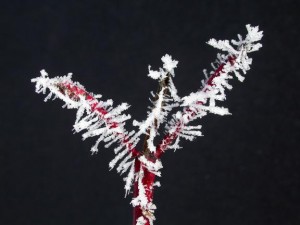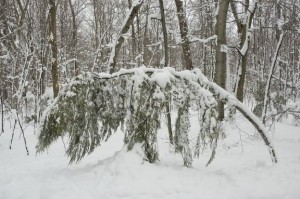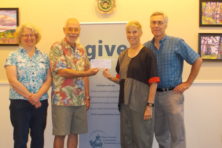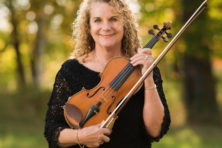Door to Nature
- Share
- Tweet
- Pin
- Share
What a fantastic slow gentle snowfall greeted me early Friday morning, this past January 25, as I fed the birds before sunrise. Every few seconds I’d stop to carefully examine the awesome and fairly large stellar snow crystals, perhaps one-tenth of an inch or even wider, that had landed on my smooth dark nylon jacket. My feeding routine took me two or three times longer than normal. A short time later Charlotte asked me as we ate breakfast, “I noticed you looking down at your jacket a lot when you were outside – were you admiring the snowflakes?”
Later that morning we drove to Egg Harbor to do some shopping and noticed many snow crystals adhering both to the slanting windshield and the vertical side windows. Fortunately the cold car, which had been parked in our unheated garage, provided some of those delicate and fragile “gems from cloudland” the perfect surface on which to stick, almost as though they had been glued in place.
The words “snow crystal” and “snowflake” are frequently used interchangeably. Technically, according to the world’s greatest amateur snow scientist of his time, “Snowflake” Bentley (1865-1931), a cluster of individual snow crystals clumped together comprises what is more accurately called a snowflake.
Snow to us kids back in the 1930s and early ‘40s, who walked to and from school every day, meant friendly snowball fights, building snow forts, sliding on our bobsleds or “Fliers” down the gloriously steep hills in Kewaunee, making a little spending money by shoveling snow, or taking long and sometimes rather daring hikes along the frozen shore of Lake Michigan.
I can remember only one teacher during my K-12 grades, all in the same building, encouraging us to look around us in winter. Miss Doris Schubert taught language arts in grades 6-8 and was especially strong with poetry. She heightened our awareness of the snow-covered landscape via John Greenleaf Whittier’s great poem, “Snowbound.” So memorable was one of her assignments, to draw a picture of different outdoor objects decorated in white, that I can practically recall what I produced.
The portion of Whittier’s famous poem: “The old familiar sights of ours, Took marvelous shapes; strange domes and towers Rose up where sty or corn crib stood,” strongly appealed to me. My dad at the time owned and ran his 80-acre home farm southwest of Casco and my brothers and I spent much time helping there on weekends and in summer. It was some of the snow-covered fence post-tops, corn crib, the old farm wagon parked outside, and other favorite objects which I drew into my assignment.
It is in retrospect, having become so fond during the past 29 years of the fascinating life and work of “Snowflake” Bentley that I can only wish some of my early teachers would have learned of this man and had shared his exciting accomplishments with us. What a great role model he would have been!
A simple suggestion, for example, could have been presented to especially the lower grade teachers to have enough small dark cloth patches, one for each student and to keep the cloth pre-cooled outdoors ready for the start of a nice snowfall. In minutes the students would have on their jackets, head outside, place a dark patch of cloth on an arm, and allow the snow crystals to fall into place. Even without the help of a magnifying glass, while breathing slowly out of the side of our mouth and away from the simple collecting area on our arm, our young eyes could be brought close enough to the crystals to admire their intricacies.
Surely the high school biology department would part with one of their old microscopes for a day and be willing to demonstrate to a teacher the proper use of the instrument, keep it safely pre-cooled outdoors, and really startle some of the students with an ultra close-up view of the crystals. Just imagine the number of the young students who would “order” a simple beginner’s microscope for Christmas!
This is precisely how young “Snowflake” Bentley, at age 15 in 1880, got totally turned onto what became his passion, a lifetime of photographing snow crystals through a microscope while at the same time being a small Vermont dairy farmer all his life. A favorite winter book in our library, “Snow Crystals” by W.A. Bentley and W.J. Humphreys, fortunately still published now by Dover Publishing Co., consists of 2,453 illustrations chosen from the 6,000 or more pictures of the bewildering variety of snowflakes (crystals) and related formations he took, most of them through his microscope.
Snowflake Bentley will appear “in person” to tell about his exciting life, and even to demonstrate some of his scientific equipment, at the Crossroads Nature Center at Sturgeon Bay starting at 7:30 pm on Friday, February 8.
Do you think you have a lot of snow? We just heard from our friends, the Kordes’ near Ahmeek, north of Calumet in the U.P. of Michigan. To date they’ve had 14 feet (168 inches) of snow, compared to their all-time record of 390.4 inches (around 32 feet) during the winter of 1978-79. Wouldn’t Mr. Bentley have been in a virtual paradise!






